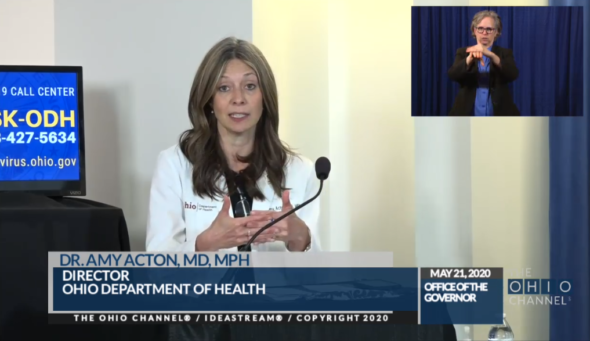
Ohio Department of Health Director Dr. Amy Acton discussed the new health order and advisory at the May 21 governor's press briefing.
Caution advised as stay-at-home restrictions lifted in Ohio
- Published: May 21, 2020
Ohio Department of Health Director Dr. Amy Acton sounded a strong note of caution as the state officially lifted its stay-at-home restrictions on May 20.
Dr. Acton released an “Urgent Health Advisory” at the same time she issued a new order rescinding key parts of the previous “Stay Safe Ohio” order that had required Ohioans to stay at home except to engage in certain activities and businesses.
Issued April 30, the “Stay Safe Ohio” order was set to expire on May 29, but the new order withdraws or modifies its provisions prior to that date. The “Stay Safe Ohio” order replaced a previous, more stringent order, originally put in place March 22 in the initial phases of the pandemic in Ohio.
Under the most recent order, Ohioans are not longer required to stay at home as much as possible. The order also withdraws portions of previous travel-related measures that required social distancing on public transit and self-quarantine for those traveling into Ohio from out of state. However, the detailed guidelines for businesses, including social distancing, employee health monitoring and telework provisions, are not rescinded and remain in effect.
Alongside the May 20 order, Dr. Acton issued an advisory, subtitled “Ohioans Protecting Ohioans,” that stresses the continued health threat of COVID-19 and urges Ohioans to protect each other by taking precautions against spreading the virus.
The coronavirus “is still with us, it is dangerous and deadly,” the advisory states. The document urges Ohioans to exercise “personal responsibility and accountability to others,” though doesn’t specify what measures individuals should take. And it notes that “although some restrictions can be loosened, our individual obligation to each other matters now more than ever.”
The advisory does offer specific guidance to those most at risk from COVID-19. People over 65 and people of all ages with certain underlying health conditions are advised, but not required, to stay at home as much as possible; avoid places where they would be exposed to an increased number of people; wear a mask; and practice good hand-washing hygiene.
Underlying health conditions that put people at greater risk include chronic lung disease, moderate to severe asthma, serious heart conditions, severe obesity, diabetes, chronic kidney disease and liver disease. People who are immunocompromised are also more at risk.
The elderly make up the majority of hospital admissions and deaths from the virus, with three-quarters of COVID-19 deaths in Ohio occurring among those 70 and over.
Those who are not considered higher risk are still advised to take precautions to limit the spread of the illness, particularly given that individuals can carry and transmit the virus in the absence of symptoms.
While about 95% of the Ohio economy will have reopened by the end of May, the coronavirus continues to spread in the state. As of May 21, Ohio COVID-19 cases topped 30,000, with 1,836 total deaths and 5,295 hospitalizations. Cases, deaths, hospitalizations and ICU admissions continue to show a steady rise.
2 Responses to “Caution advised as stay-at-home restrictions lifted in Ohio”
The Yellow Springs News encourages respectful discussion of this article.
You must login to post a comment.
Don't have a login? Register for a free YSNews.com account.













Duke, I don’t know the answer to your first question, but it’s a good one. I recently read in the New York Times that the federal government and some states are drafting/passing legislation to grant “Covid-19 immunity” to nursing homes and other corporations. See this opinion piece:
https://www.nytimes.com/2020/05/20/opinion/nursing-homes-coronavirus-liability.html?action=click&module=Opinion&pgtype=Homepage
Regarding your second observation, the statement that the “urgent health advisory” doesn’t specify measures refers to the measures individuals can/should take. (I’ve clarified that part of the story.) You’re right that the business guidelines are clearly specified and remain in place; that portion of the “Stay Safe Ohio” order still pertains.
–Audrey
If individuals or businesses fail to exercise precautions that would help protect the most vulnerable, including older Americans , can and will these entities be held accountable via possibly individual or even class action lawsuits, as it would seem to suggest a form of age and/or disability discrimination other than just ‘lack of concern for others’. I really hope legal consultants and advocates are looking into this.
Suggestions maintain “personal responsibility and accountability to others,” though doesn’t specify what measures to take” yet the guidelines have been posted and published enough that business enterprises could not plead ignorance of what they are.